Submitted:
23 November 2023
Posted:
24 November 2023
You are already at the latest version
Abstract
Keywords:
1. Introduction
2. Geological Setting
3. Materials and Methods
3.1. Geochemical Analyses
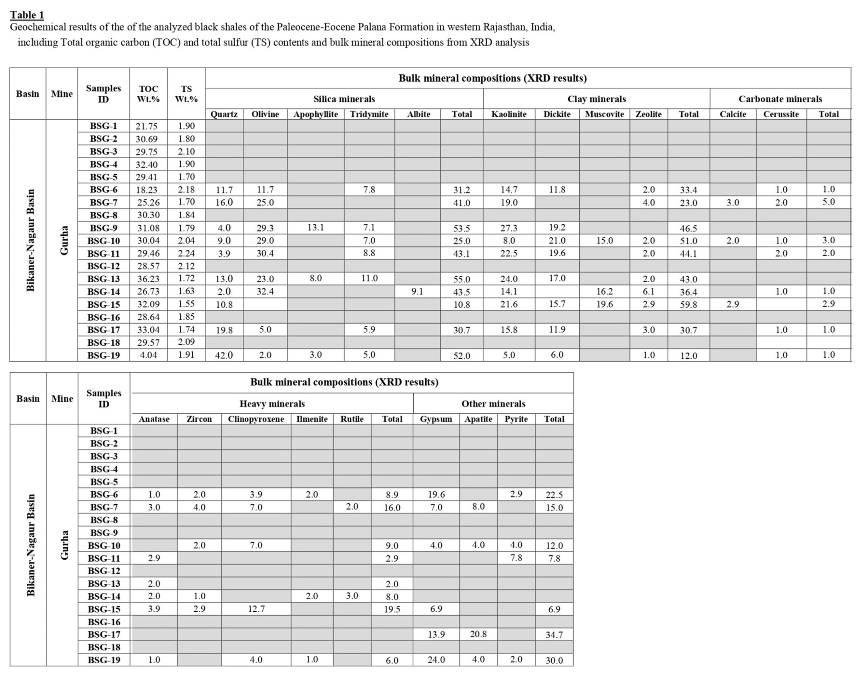
3.2. Optical-Microscopic Examinations
3.3. Mineralogical and Elemental Compositions Analyses
4. Results
4.1. Total Organic Carbon (TOC) and Sulfur (S) Contents
4.2. Organic Facies Characteristics
4.3. Mineralogical Composition and Lithotype
4.4. Major Oxides and Trace Elements
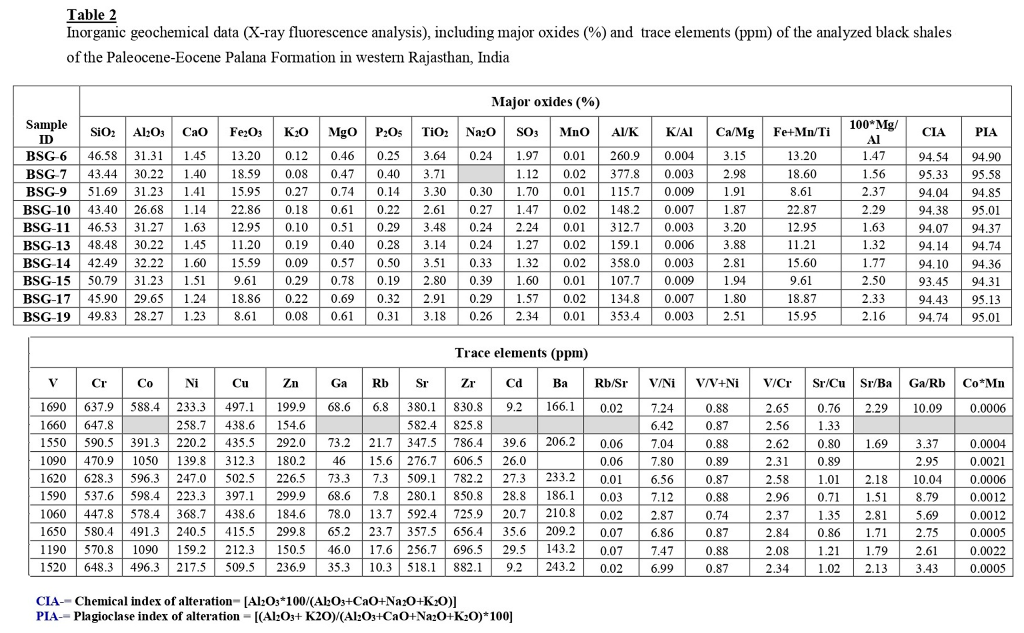
5. Discussion
5.1. Sedimentary Depositional Environment during the Paleocene-Eocene
5.2. Paleoclimate Evolution during the Paleocene-Eocene
5.3. Hydrothermal and Volcanic Activity during the Paleocene-Eocene
6. Conclusions
- The black shale facies of the Paleocene-Eocene Palana Formation exhibit rich TOC and S contents of up to 36.23 wt. % and 2.24 wt. %, respectively, revealing normal marine setting and anoxic environmental conditions.
- The Palana shales are clay-rich lithofacies, ranging from siliceous mudstone to silica-rich argillaceous mudstone, with high abundance of clay and silica minerals, as indicated by XRD data together with species identification (SPI) and SEM of the QEMSCAN results.
- Microscopic examinations reveal that the OM in the Palana clay-rich facies was primarily derived from algae and other bacterial organism, along with foraminifer assemblages, which favored marine anoxic environmental conditions.
- Different redox-sensitive trace elements along with their ratios of the clay-rich shale facies of the Palana Formation indicate anoxic environmental conditions were recognized during the Paleocene-Eocene period.
- The mineralogical and elemental compositions show warm and humid climates, with an intensive degree of chemical weathering took place during the deposition of the Paleocene-Eocene Palana clay-rich facies.
- The results highlighted in this study suggest that the high organic carbon accumulation in the black shale facies of the Palana Formation was mainly controlled by the sedimentary factors i.e., high bioproductivity and preservation of organic matter together with volcanic activities during the Paleocene-Eocene period
Acknowledgments
Conflicts of Interest
References
- Adachi, M.; Yamamoto, K.; Sugisaki, R. Hydrothermal chert and associated siliceous rocks from the northern Pacific their geological significance as indication of ocean ridge activity. Sediment. Geol. 1986, 47, 125–148. [Google Scholar] [CrossRef]
- Adegoke, A.K.; Abdullah, W.H.; Hakimi, M.H.; Sarki Yandoka, B.M. Geochemical characterisation of Fika Formation in the Chad (Bornu) Basin, northeastern Nigeria: implications for depositional environment and tectonic setting. Appl. Geochem. 2014, 43, 1–12. [Google Scholar] [CrossRef]
- Ahmed, A.; Jahandad, S.; Hakimi, M.H.; Gharib, A.F.; Mehmood, S.; Kahal, A.Y.; Lashin, A. Organic matter characteristics and conventional oil potentials of shales from the Early Jurassic Datta Formation in the Upper Indus Basin, Northern Pakistan. Journal of Asian Earth Sciences. 2022, 224, 104975. [Google Scholar] [CrossRef]
- Algeo, T.J.; Liu, J.S. A re-assessment of elemental proxies for paleoredox analysis. Chem. Geol. 2020, 540, 119549. [Google Scholar] [CrossRef]
- Algeo, T.J.; Maynard, J.B. Trace-element behavior and redox facies in core shales of Upper Pennsylvanian Kansas-type cyclothems. Chem. Geol. 2004, 206, 289–318. [Google Scholar] [CrossRef]
- Al-Husseini, M.I. Origin of the Arabian plate structures: Amar collision and Najd Rift. Geo Arabia. 2000, 5, 527–542. [Google Scholar] [CrossRef]
- Alqubalee, A.M.; Babalola, L.O.; Abdullatif, O.M.; Eltom, H.A. Geochemical Characterization of Subsurface Upper Ordovician Glaciogenic Deposits: Implications for Provenance, Tectonic Setting, and Depositional Environments. Arab. J. Sci. Eng. 2021, 47, 7273–7291. [Google Scholar] [CrossRef]
- Amao, A.O.; Al-Otaibi, B.; Al-Ramadan, K. High-resolution X–ray diffraction datasets: Carbonates. Data Br. 2022, 42, 108204. [Google Scholar] [CrossRef]
- Armstrong-Altrin, J.S.; Ramos-Vázquez, M.A.; Hermenegildo-Ruiz, N.Y.; Madhavaraju, J. Microtexture and U–Pb geochronology of detrital zircon grains in the Chachalacas beach, Veracruz State, Gulf of Mexico. Geological J. 2020, 56, 2418–2438. [Google Scholar] [CrossRef]
- Ayling, B.; Rose, P.; Petty, S.; Zemach, E.; Drakos, P. QEMSCAN® (Quantitative Evaluation of Minerals by Scanning Electron Microscopy): capability and application to fracture characterization in geothermal systems. Geotherm. PROCEEDINGS, Thirty-Seventh Workshop on Geothermal Reservoir Engineering, Stanford University, Stanford, California, January 30 - February 1, 2012.
- Bai, Y.Y.; Liu, Z.J.; Sun, P.C.; Liu, R.; Hu, X.F.; Zhao, H.Q.; Xu, Y.B. Rare earth and major element geochemistry of Eocene fine-grained sediments in oil shale and coal-bearing layers of the Meihe Basin, Northeast China. J. Asian Earth Sci. 2015, 97, 89–101. [Google Scholar] [CrossRef]
- Bechtel, A.; Gratzer, R.; Sachsenhofer, R.F. Chemical characteristics of upper cretaceous (Turonian) jet of the gosau group of gams/hieflau (styria, Austria). Int. J. Coal Geol. 2001, 46, 27–49. [Google Scholar] [CrossRef]
- Bechtel, A.; Jia, J.L.; Strobl, S.A.I.; Sachsenhofer, R.F.; Liu, Z.J.; Gratzer, R.; Püttmann, W. Paleoenvironmental conditions during deposition of the Upper Cretaceous oil shale sequences in the Songliao Basin (NE China): implications from geochemical analyses. Organic Geochemistry. 2012, 46, 76–95. [Google Scholar] [CrossRef]
- Beckmann, B.; Flogel, S.; Hofmann, P.; Schulz, M.; Wagner, T. Orbital forcing of Cretaceous river discharge in tropical Africa and ocean response. Nature. 2005, 437, 241–244. [Google Scholar] [CrossRef] [PubMed]
- Berner, R.A.; Raiswell, R. Burial of organic carbon and pyrite sulfur in sediments over Phanerozoic time: a new theory. Geochim. Cosmochim. Acta. 1983, 47, 855–862. [Google Scholar] [CrossRef]
- Bordenave, M.L.; Espitalié, J.; Leplat, P.O.J.L.; Oudin, J.L.; Vandenbroucke, M. Screening techniques for source rock evaluation. Applied petroleum geochemistry: 1993. pp. 217–278.
- Boström, K.; Kraemer, T.; Gartner, S. Provenance and accumulation rates of opaline silica, Al, Ti, Fe, Mn, Cu, Ni and Co in Pacific pelagic sediments. Chem. Geol. 1973, 11, 123–148. [Google Scholar] [CrossRef]
- Brumsack, H.J. The trace metal content of recent organic carbon-rich sediments: implications for Cretaceous black shale formation. Palaeogeogr. Palaeoclimatol. Palaeoecol. 2006, 232, 344–361. [Google Scholar] [CrossRef]
- Calvert, S.E.; Pedersen, T.F. Chapter fourteen elemental proxies for palaeoclimatic and palaeoceanographic variability in marine sediments: interpretation and application. Developments in marine geology. 2007, 1, 567–644. [Google Scholar]
- Carroll, A.R.; Bohacs, K.M. Stratigraphic classification of ancient lakes: balancing tectonic and climatic controls. Geology. 1999, 27, 99–102. [Google Scholar] [CrossRef]
- Chen, X.; Zhang, B.; Huang, H.; Mao, Z. Controls on Organic Matter Accumulation of the Triassic Yanchang Formation Lacustrine Shales in the Ordos Basin, North China. ACS Omega. 2021, 6, 26048–26064. [Google Scholar] [CrossRef]
- Conway, T.M.; John, S.G. Biogeochemical cycling of cadmium isotopes along a highresolution section through the North Atlantic Ocean. Geochim. Cosmochim. Acta. 2015, 148, 269283. [Google Scholar] [CrossRef]
- Dashtgard, S.E.; Wang, A.; Pospelova, V.; Wang, P.-L.; La Croix, A.; Ayranci, K. Salinity indicators in sediment through the fluvial-to-marine transition (Fraser River, Canada). Sci. Rep. 2022, 12, 14303. [Google Scholar] [CrossRef] [PubMed]
- Deng, H.W.; Qian, K. Analysis on Sedimentary Geochemistry and Environment; Science Technology Press: Gansu, 1993; pp. 15–85. (In Chinese) [Google Scholar]
- Dmitry, A.; Al-Husseini, M.I.; Yumiko, I. Review of middle east paleozoic plate tectonics. Geo Arabia. 2007, 12, 5–56. [Google Scholar]
- Duggen, S.; Olgun, N.; Croot, P.; Hoffmann, L.; Dietze, H.; Delmelle, P.; Teschner, C. The role of airborne volcanic ash for the surface ocean biogeochemical iron-cycle: A review. Biogeosciences. 2010, 7, 827–844. [Google Scholar] [CrossRef]
- Fedo, C.M.; Nesbitt, H.W.; Young, G.M. Unraveling the effects of potassium metasomatism in sedimentary rocks and paleosols, with implications for paleoweathering conditions and provenance. Geology. 1995, 23, 921–924. [Google Scholar] [CrossRef]
- Felix, N.S. Physico-Chemical Studies on Bentonites with Special Reference to Fayoum Deposits. Ph.D. Thesis, Fac. of Sci., Cairo, Univ, Egypt, 1977. [Google Scholar]
- Galarraga, F.; Reategui, K.; Martïnez, A.; Martínez, M.; Llamas, J.F.; Marquez, G. V/Ni ratio as a parameter in palaeoenvironmental characterisation of nonmature medium-crude oils from several Latin American basins. J. Pet. Sci. Eng. 2008, 61, 9–14. [Google Scholar] [CrossRef]
- Hatch, J.R.; Leventhal, J.S. Relationship between inferred redox potential of the depositional environment and geochemistry of the upper pennsylvanian (missourian) Stark shale member of the dennis limestone, wabaunsee county, Kansas, USA. Chem. Geol. 1992, 99, 65–82. [Google Scholar] [CrossRef]
- Hakimi, M.H.; Wan, H.A.; Shalaby, M.R. Organic geochemical characteristics and depositional environments of the Jurassic shales in the Masila Basin of Eastern Yemen. GeoArabia. 2011, 16, 47–64. [Google Scholar] [CrossRef]
- Hakimi, M.H.; Wan Hasiah, A.; Shalaby, M.R. Molecular composition and organic petrographic characterization of Madbi source rocks from the Kharir Oilfield of the Masila Basin (Yemen): palaeoenvironmental and maturity interpretation. Arab. J. Geosci. 2012, 5, 817–831. [Google Scholar] [CrossRef]
- Hakimi, M.H.; Wan Hasiah, A. Organic geochemical characteristics and oil generating potential of the Upper Jurassic Safer shale sediments in the Marib-Shabowah Basin, western Yemen. Organic Geochemistry. 2013, 54, 115–124. [Google Scholar] [CrossRef]
- Hakimi, M.H.; Abdullah, W.H.; Alqudah, M.; Makeen, Y.M.; Mustapha, K.A. Reducing marine and warm climate conditions during the Late Cretaceous, and their influence on organic matter enrichment in the oil shale deposits of North Jordan. Int. J. Coal Geol. 2016, 165, 173–189. [Google Scholar] [CrossRef]
- Hatem, B.A.; Abdullah, W.H.; Hakimi, M.H.; Mustapha, K.A. Origin of organic matter and paleoenvironment conditions of the Late Jurassic organic-rich shales from Shabwah sub-basin (western Yemen): Constraints from petrology and biological markers. Marine and Petroleum Geology. 2016, 72, 83–97. [Google Scholar] [CrossRef]
- He, T.H.; Lu, S.F.; Li, W.H.; Sun, D.Q.; Pan, W.Q.; Zhang, B.S.; Tan, Z.Z.; Ying, J.F. Paleoweathering, hydrothermal activity and organic matter enrichment during the formation of earliest Cambrian black strata in the Northwest Tarim Basin, China. J. Pet. Sci. Eng. 2020, 189, 106987. [Google Scholar] [CrossRef]
- Hieronymus, B.; Kotschoubey, B.; Boulegue, J. Gallium behavior in some contrasting lateritic profiles from Cameroon and Brazil. J. Geochem. Explor. 2001, 72, 147–163. [Google Scholar] [CrossRef]
- Jarvie, D.M.; Hill, R.J.; Ruble, T.E.; Pollastro, R.M. Unconventional shale-gas systems: The Mississippian Barnett Shale of north-central Texas as one model for thermogenic shale-gas assessment. AAPG bulletin. 2007, 91, 475–499. [Google Scholar] [CrossRef]
- Jia, J.; Bechtel, A.; Liu, Z.; Susanne, A.I.; Strobl, P.S.; Reinhard, F.S. Oil shale formation in the upper cretaceous nenjiang formation of the songliao basin (NE China): implications from organic and inorganic geochemical analyses. Int. J. Coal Geol. 2013, 113, 11–26. [Google Scholar] [CrossRef]
- Jones, B.; Manning, D.A. Comparison of geochemical indices used for the interpretation of palaeoredox conditions in ancient mudstones. Chem. Geol. 1994, 111, 111–129. [Google Scholar] [CrossRef]
- Katz, B.J. Controlling factors on source rock developmentda review of productivity, preservation and sedimentation rate. In: The Deposition of Organic-carbon-rich Sediments: Models, Mechanisms, and Consequences; Harris, N.B.; Ed.; SEPM Special Publication, 2005; Volume 82, pp. 7–16.
- Kumar, A. Tertiary Coal and Lignite Deposits of India and their Source Rock Potential: A Review on the Contribution of the Indian Coal Petrologists. Journal of the Geological Society of India. 2022, 98, 1745–1753. [Google Scholar] [CrossRef]
- Kumar, A.; Singh, A.K.; Paul, D.; Kumar, A. Evaluation of hydrocarbon potential with insight into climate and environment present during deposition of the Sonari lignite, Barmer Basin Rajasthan. Energy and Climate Change. 2020, 1, 100006. [Google Scholar] [CrossRef]
- Kumar, A.; Hakimi, M.H.; Singh, A.K.; Abdullah, W.H.; Zainal Abidin, N.S.; Rahim, A.; Mustapha, K.A.; Yelwa, N.A. Geochemical and Petrological Characterization of the Early Eocene Carbonaceous Shales: Implications for Oil and Gas Exploration in the Barmer Basin, Northwest India. ACS omega. 2022, 7, 42960–42974. [Google Scholar] [CrossRef]
- Langmann, B.; Zaksek, K.; Hort, M.; Duggen, S. Volcanic ash as fertilizer for the surface ocean. Atmos. Chem. Phys. 2010, 10, 38913899. [Google Scholar] [CrossRef]
- Lei, B.; Que, H.P.; Hu, N.; Niu, Z.J.; Wang, H. Geochemistry and sedimentary environments of the Palaeozoic siliceous rocks in western Hubei. Sediment. Geol. Tethyan Geol. 2002, 22, 70–79, (in Chinese with English abstract). [Google Scholar]
- Li, T.Y.; He, S.; Yang, Z. The marine source rock formation conditions and control factors. Geological Science and Technology Information. 2008, 27, 63–70, (in Chinese with English abstract). [Google Scholar]
- Lu, Y.; Jiang, S.; Lu, Y.; Xu, S.; Shu, Y.; Wang, Y. Productivity or preservation? The factors controlling the organic matter accumulation in the late Katian through Hirnantian Wufeng organic-rich shale, South China. Mar. Petrol. Geol. 2019, 109, 22–35. [Google Scholar] [CrossRef]
- Lyons, T.W.; Werne, J.P.; Hollander, D.J.; Murray, R.W. Contrasting sulfur geochemistry and Fe/Al and Mo/Al ratios across the last oxic-to-anoxic transition in the Cariaco Basin, Venezuela. Chem. Geol. 2003, 195, 131–157. [Google Scholar] [CrossRef]
- Makeen, Y.M.; Hakimi, M.H.; Abdullah, W.H. The origin, type and preservation of organic matter of the Barremian-Aptian organic-rich shales in the Muglad Basin, Southern Sudan, and their relation to paleoenvironmental and paleoclimate conditions. Mar. Pet. Geol. 2015, 65, 187–197. [Google Scholar] [CrossRef]
- Mathews, R.P.; Singh, B.D.; Singh, V.P.; Singh, A.; Singh, H.; Shivanna, M.; Dutta, S.; Mendhe, V.A.; Chetia, R. Organo-petrographic and geochemical characteristics of Gurha lignite deposits, Rajasthan, India: Insights into the palaeovegetation, palaeoenvironment and hydrocarbon source rock potential. Geoscience Frontiers. 2020, 11, 965–988. [Google Scholar] [CrossRef]
- Mohialdeen, I.M.J.; Hakimi, M.H.; Al-Beyati, F.M. Geochemical and petrographic characterization of late Jurassic-early cretaceous Chia Gara formation in northern Iraq: palaeoenvironment and oil-generation potential. Mar. Petrol. Geol. 2013, 43, 166–177. [Google Scholar] [CrossRef]
- Moradi, A.V.; Sarı, A.; Akkaya, P. Geochemistry of the Miocene oil shale (hançili formation) in the Çankırı-Çorum basin, Central Turkey: implications for paleoclimate conditions, source–area weathering, provenance and tectonic setting. Sediment. Geol. 2016, 341, 289–303. [Google Scholar] [CrossRef]
- Mukherjee, M.; Misra, S. A review of experimental research on Enhanced Coal Bed Methane (ECBM) recovery via CO2 sequestration. Earth-Science Reviews. 2018, 179, 392–410. [Google Scholar] [CrossRef]
- Nesbitt, H.W.; Young, G.M. Early Proterozoic climates and plate motions inferred from major element chemistry of lutites. Nature. 1982, 299, 715–717. [Google Scholar] [CrossRef]
- Omar, N.; McCann, T.; Al-Juboury, A.I.; Franz, S.O. Petrography and geochemistry of the Middle-Upper Jurassic Banik section, northernmost Iraq—implications for paleoredox, evaporitic and diagenetic conditions. N. Jb. Geol. Paleont. Abh. 2020, 297, 125–152. [Google Scholar] [CrossRef]
- Orhan, H.; Delikan, A.; Demir, A.; Kapan, S.; Olgun, K.; Ozmen, A.; Sayin, Ü.; Ekici, G.; Aydin, H.; Nazik, A. Geochemical evidences of paleoenvironmental changes in late quaternary lacustrine sediments of the konya closed basin (konya, Turkey). In Patterns and Mechanisms of Climate, Paleoclimate and Paleoenvironmental Changes from Low Latitude Regions; Zhang, Z.; Khelifi, N.; Mezghani, A.; Heggy, E.; Eds.; Springer Berlin, Germany, 2019; pp. 73–76.
- Pollastro, R.M. Ghaba Salt Basin province and Fahud Salt Basin province—Oman: geological overview and total petroleum systems. United States Geol Sur Bull. 1999, 2167, 1–41. [Google Scholar]
- Price, G.D. The evidence and implications of polar-ice during the Mesozoic. Earth Sci. Rev. 1999, 48, 183–210. [Google Scholar] [CrossRef]
- Qi, H.W.; Hu, R.Z.; Su, W.C.; Qi, L.; Feng, J.Y. Continental hydrothermal sedimentary siliceous rock and genesis of superlarge germanium (Ge) deposit hosted in coal: a study from the Lincang Ge deposit, Yunnan, China. Sci. China Ser. D Earth Sci. 2004, 47, 973–984. [Google Scholar] [CrossRef]
- Qian, G.; Li, Y.; Gerson, A.R. Applications of surface analytical techniques in Earth Sciences. Surf. Sci. Rep. 2015, 70, 86–133. [Google Scholar] [CrossRef]
- Ran, B.; Liu, S.; Jansa, L.; Sun, W.; Yang, D.; Ye, Y.; Wang, S.; Luo, C.; Zhang, X.; Zhang, C. Origin of the Upper Ordovician–lower Silurian cherts of the Yangtze block, South China, and their palaeogeographic significance. J. Asian Earth Sci. 2015, 108, 1–17. [Google Scholar] [CrossRef]
- Ratcliffe, K.T.; Wright, A.M.; Hallsworth, C.; Morton, A.; Zaitlin, B.A.; Potocki, D.; Wray, D.S. Alternative correlation techniques in the petroleum industry: an example from the (lower cretaceous) basal quartz, southern Alberta. Bullet. Am. Assoc. Pet. Geol. 2004, 88, 419–432. [Google Scholar]
- Read, J.F.; Kerans, C.; Weber, L.J.; Sarg, H.F.; Wright, F.M. Milankovitch sea-level changes, cycles and reservoirs on carbonate platforms in green-house and ice-house worlds. SEPM Short. Course. 1995, 35, 1–81. [Google Scholar]
- Remírez, M.N.; Algeo, T.J. Paleosalinity determination in ancient epicontinental seas: a case study of the T-OAE in the Cleveland Basin (UK). Earth Sci. Rev. 2020, 201, 103072. [Google Scholar] [CrossRef]
- Roy, A.B.; Jakhar, S.R. Geology of Rajasthan (Northwest India) precambrian to recent. Scientific Publishers. 2002.
- Schopf, J.M. Field description and sampling of coal beds; US Government Printing Office: Washington, DC, 1960; p. 67. [Google Scholar]
- Schwarzkopf, T.A. Model for prediction of organic carbon in possible source rocks. Maine Pet. Geol. 1993, 10, 478–492. [Google Scholar] [CrossRef]
- Singh, P.K.; Rajak, P.K.; Singh, V.K.; Singh, M.P.; Naik, A.S.; Raju, S.V. Studies on thermal maturity and hydrocarbon potential of lignites of Bikaner–Nagaur basin, Rajasthan. Energy Exploration & Exploitation. 2016, 34, 140–157. [Google Scholar]
- Singh, A.; Shivanna, M.; Mathews, R.P.; Singh, B.D.; Singh, H.; Singh, V.P.; Dutta, S. Paleoenvironment of Eocene lignite bearing succession from Bikaner-Nagaur Basin, western India: organic petrography, palynology, palynofacies and geochemistry. International Journal of Coal Geology. 2017, 181, 87–102. [Google Scholar] [CrossRef]
- Singh, A.K.; Kumar, A.; Hakimi, M.H. Organic geochemical and petrographical characteristics of the Nagaur lignites, Western Rajasthan, India and their relevance to liquid hydrocarbon generation. Arabian Journal of Geosciences. 2018, 11, 1–15. [Google Scholar] [CrossRef]
- Singh, A.K.; Hakimi, M.H.; Kumar, A.; Ahmed, A.; Abidin, N.S.Z.; Kinawy, M.; Mahdy, O.E.; Lashin, A. Geochemical and organic petrographic characteristics of high bituminous shales from Gurha mine in Rajasthan, NW India. Scientific reports. 2020, 10, 1–19. [Google Scholar] [CrossRef] [PubMed]
- Singh, V.P.; Singh, B.D.; Mathews, R.P.; Singh, A.; Mendhe, V.A.; Mishra, S.; Banerjee, M. Paleodepositional and Hydrocarbon Source-Rock Characteristics of the Sonari Succession (Paleocene), Barmer Basin, NW India: Implications from Petrography and Geochemistry. Natural Resources Research. 2022, 31, 2943–2971. [Google Scholar] [CrossRef]
- Shu, T.; Dazhen, T.; Hao, X.; Jianlong, L.; Xuefeng, S. Organic geochemistry and elements distribution in Dahuangshan oil shale, southern Junggar Basin: origin of organic matter and depositional environment. Int. J. Coal Geol. 2013, 115, 41–51. [Google Scholar]
- Shukla, A.; Jasper, A.; Uhl, D.; Mathews, R.P.; Singh, V.P.; Chandra, K.; Chetia, R.; Shukla, S.; Mehrotra, R.C. Paleo-wildfire signatures revealing co-occurrence of angiosperm-gymnosperm in the early Paleogene: Evidences from woody charcoal and biomarker analysis from the Gurha lignite mine, Rajasthan, India. International Journal of Coal Geology. 2023, 265, 104164. [Google Scholar] [CrossRef]
- Skinner, B. The many origins of hydrothermal mineral deposits. In Geochemistry of Hydrothermal Ore Deposits, second ed.; Barnes, H.L., Ed.; John Wiley & Sons: New York, 1979; pp. 3–21. [Google Scholar]
- Song, Y.; Liu, Z.; Meng, Q.; Xu, J.; Sun, P.; Cheng, L.; Zheng, G. Multiple controlling factors of the enrichment of organic matter in the upper cretaceous oil shale sequences of the Songliao basin, NE China: implications from geochemical analyses. Oil Shale. 2016, 33, 142–166. [Google Scholar] [CrossRef]
- Strakhov, N.M. Fundamentals of the theory of lithogenesis. M. Publishing House of the Academy of Sciences of the USSR. 1960. [Google Scholar]
- Strakhov, N.M. Problems of geochemistry of modern oceanic lithogenesis. M.; Science. 1976. [Google Scholar]
- Sweere, T.; van den Boorn, S.; Dickson, A.J.; Reichart, G.-J. Definition of new trace-metal proxies for the controls on organic matter enrichment in marine sediments based on Mn, Co, Mo and Cd concentrations. Chem. Geol. 2016, 441, 235–245. [Google Scholar] [CrossRef]
- Talbot, M.R. The Origins of Lacustrine Oil Source Rocks: Evidence from the Lakes of Tropical African Geological Society London, 1988; vol. 40, pp. 29–43. Special Publication.
- Tissot, P.; Welte, D.H. Petroleum formation and occurrence. Springer-verlag. (1984).
- Tribovillard, N.; Algeo, T.J.; Lyons, T.; Riboulleau, A. Trace metals as paleoredox and paleoproductivity proxies: an update. Chem. Geol. 2006, 232, 12–32. [Google Scholar] [CrossRef]
- Vincent, B.; Rambeau, C.; Emmanuel, L.; Loreaue, J.P. Sedimentology and trace element geochemistry of shallow-marine carbonates: an approach to paleoenvironmental analysis along the Pagny-sur-Meuse section (Upper Jurassic, France). Facies. 2006, 52, 69–84. [Google Scholar] [CrossRef]
- Wang, Z.; Fu, X.; Feng, X.; Song, C.; Wang, D.; Chen, W.; Zeng, S. Geochemical features of the black shales from the Wuyu Basin, southern Tibet: implications for paleoenvironment and paleoclimate. Geol. J. 2017, 52, 282297. [Google Scholar] [CrossRef]
- Wang, Y.; Chen, B.; Li, X.; Wang, H.; Chang, L.; Jiang, S. Sedimentary characteristics of up-welling facies shale in lower Silurian Longmaxi Formation, northeast sichuan area. Acta. Petrol. Ei. Sinica. 2018, 39, 1092–1102. [Google Scholar]
- Xie, H.; Zhou, D.; Li, Y.; Pang, X.; Li, P.; Chen, G.; Li, F.; Cao, J. Cenozoic tectonic subsidence in Deepwater sags in the Pearl River Mouth Basin, northern South China Sea. Tectonophysics. 2014, 615, 182–198. [Google Scholar] [CrossRef]
- Xu, J.; Liu, Z.; Bechtel, A.; Meng, Q.; Sun, P.; Jia, J.; Cheng, L.; Song, Y. Basin evolution and oil shale deposition during Upper cretaceous in the songliao basin (NE China): implications from sequence stratigraphy and geochemistry. Int. J. Coal Geol. 2015, 149, 9–23. [Google Scholar] [CrossRef]
- Xu, C.; Shan, X.L.; He, W.T. The fluctuation of warm paleoclimatic controls on lacustrine carbonate deposition in the Late Cretaceous (late Santonian), Southern Songliao Basin, Northeast China. Int. J. Earth Sci. 2021, 111, 85–102. [Google Scholar] [CrossRef]
- Yandoka, B.M.S.; Abdullah, W.H.; Abubakar, M.B.; Hakimi, M.H.; Adegoke, A.K. Geochemical characterization of early Cretaceous lacustrine sediments of Bima Formation, Yola Sub-basin, northern Benue trough, NE Nigeria: organic matter input, preservation, paleoenvironment and paleoclimatic conditions. Mar. Petrol. Geol. 2015, 61, 82–94. [Google Scholar] [CrossRef]
- Zhang, B.; Yao, S.; Wignall, P.B.; Hu, W.; Ding, H.; Liu, B.; Ren, Y. Widespread coastal upwelling along the eastern paleo-tethys margin (south China) during the middle Permian (Guadalupian): implications for organic matter accumulation. Mar. Petrol. Geol. 2018, 97, 113–126. [Google Scholar] [CrossRef]
- Zhang, K.; Song, Y.; Jiang, S.; Jiang, Z.; Jia, C.; Huang, Y.; Wen, M.; Liu, W.; Xie, X.; Liu, T.; Wang, P.; Shan, C.; Wang, P. Mechanism analysis of organic matter enrichment in different sedimentary backgrounds: a case study of the Lower Cambrian and the Upper Ordovician-Lower Silurian, in Yangtze region. Mar. Petrol. Geol. 2019, 99, 488–497. [Google Scholar] [CrossRef]
- Zhang, K.; Liu, R.; Liu, Z.J.; Li, L.; Wu, X.P.; Zhao, K.A. Influence of palaeoclimate and hydrothermal activity on organic matter accumulation in lacustrine black shales from the lower cretaceous Bayingebi Formation of the Yin’e Basin, China. Palaeogeogr. Palaeoclimatol. Palaeoecol. 2020, 560, 110007. [Google Scholar] [CrossRef]
- Zonneveld, K.A.F.; Versteegh, G.J.M.; Kasten, S.; Eglinton, T.I.; Emeis, K.-C.; Huguet, C.; Koch, B.P.; de Lange, G.J.; de Leeuw, J.W.; Middelburg, J.J.; Mollenhauer, G.; Prahl, F.G.; Rethemeyer, J.; Wakeham, S.G. Selective preservation of organic matter in marine environments; processes and impact on the sedimentary record. Biogeosciences. 2010, 7, 483–511. [Google Scholar] [CrossRef]
- Zou, C.; Zhu, R.; Chen, Z.Q.; Ogg, J.G.; Wu, S.; Dong, D.; Qiu, Z.; Wang, Y.; Wang, L.; Lin, S.; Cui, J.; Su, L.; Su, L.; Yang, Z. Organic-matter-rich shales of China. Earth Sci. Rev. 2019, 189, 51–78. [Google Scholar] [CrossRef]
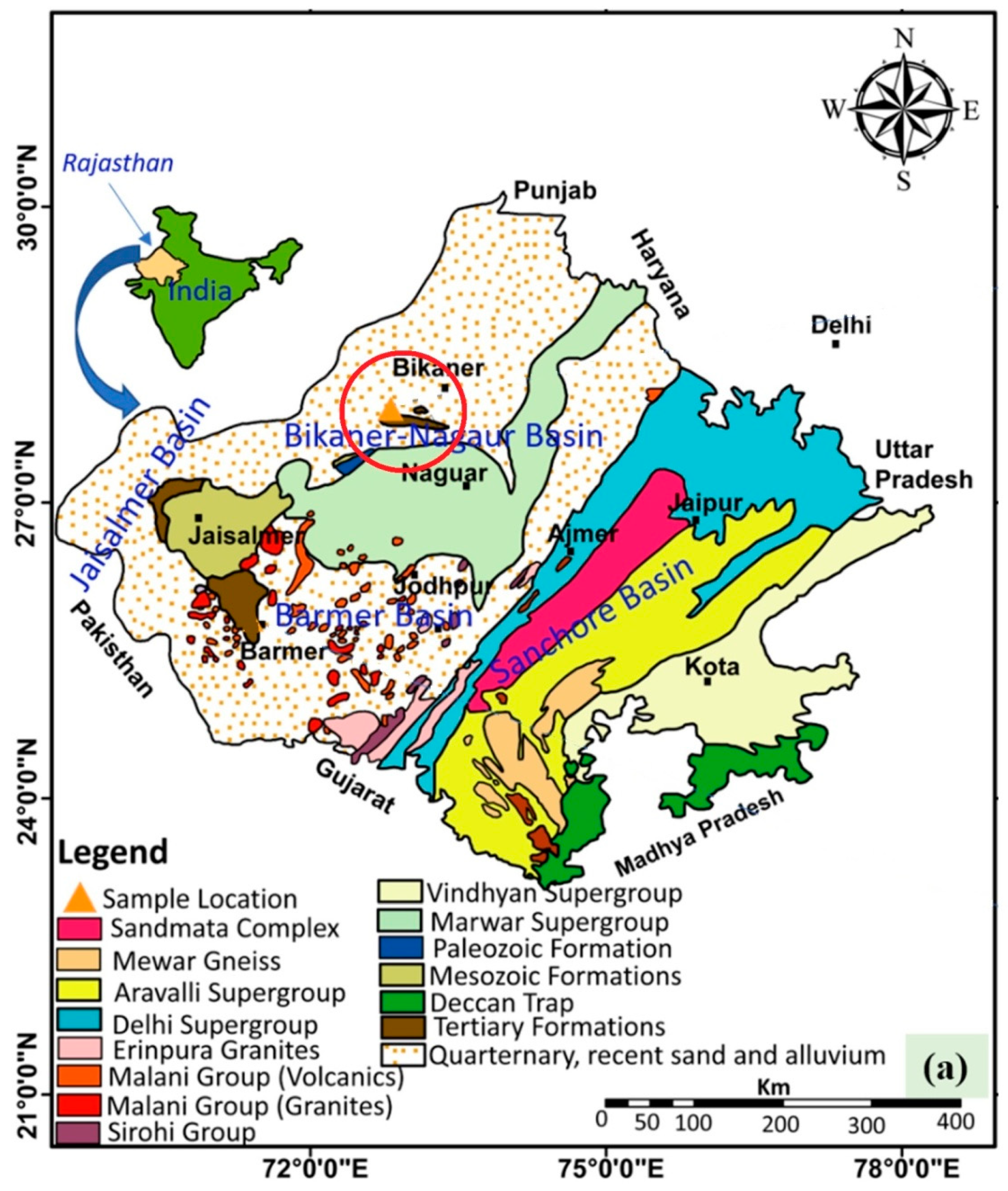

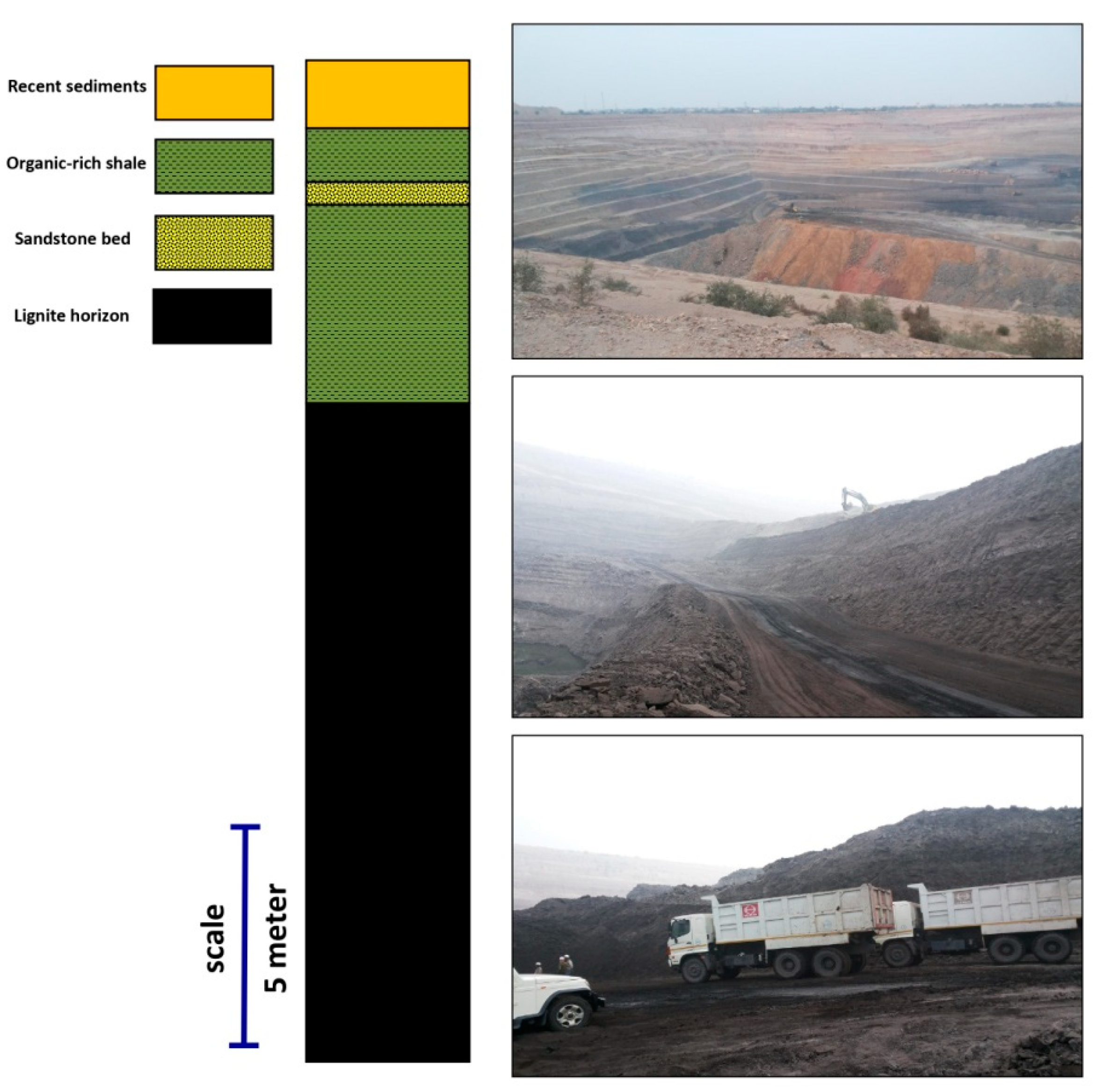

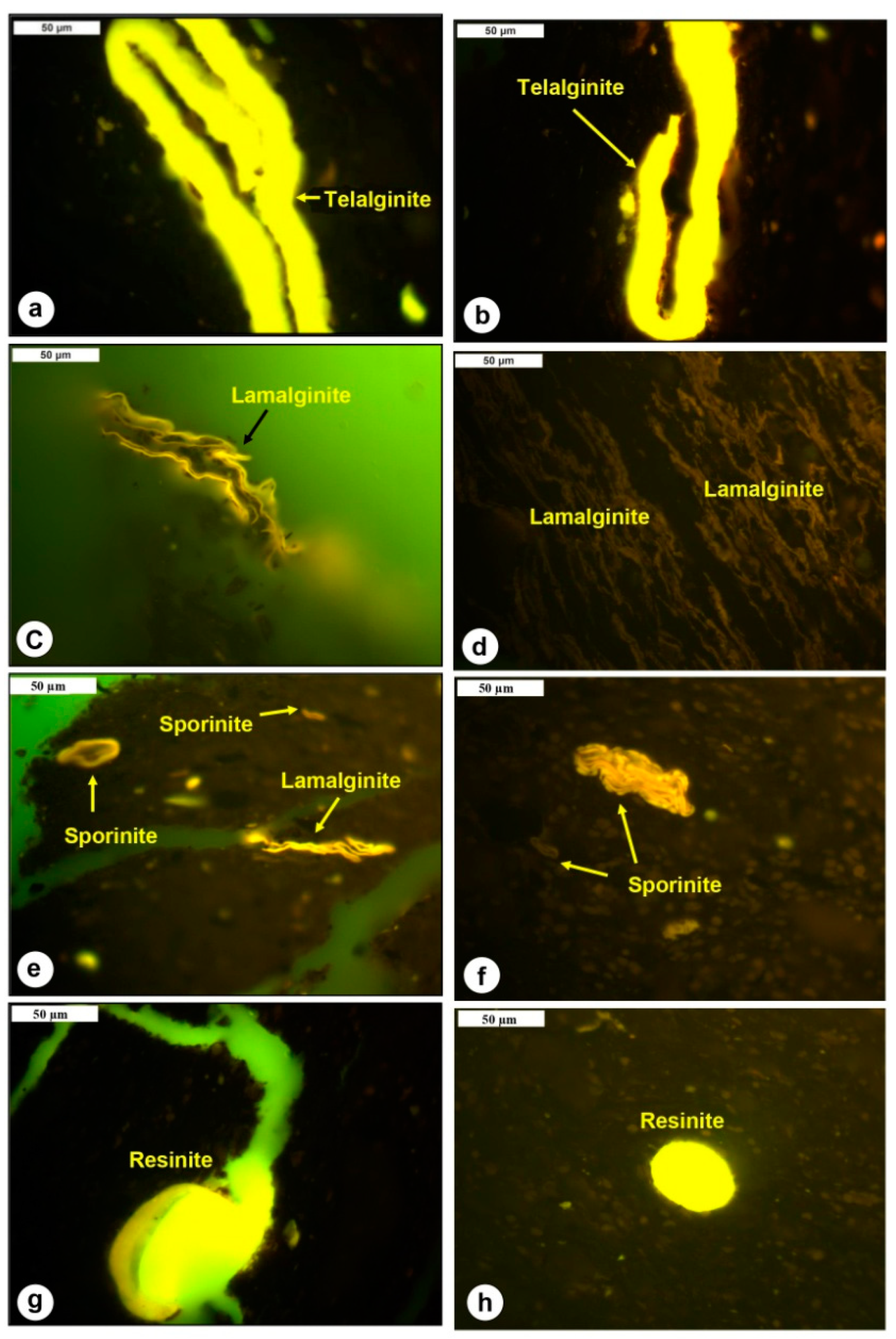
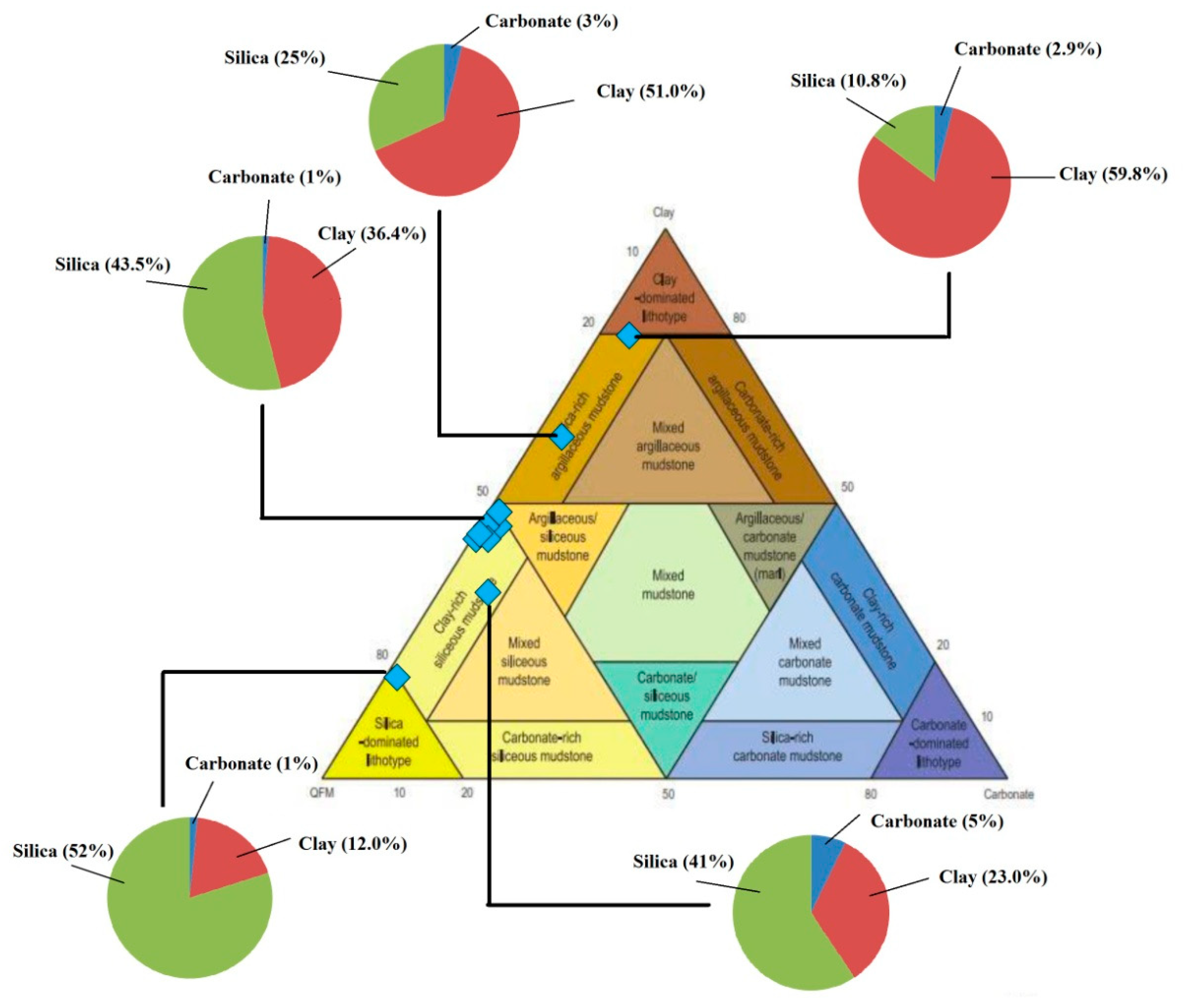
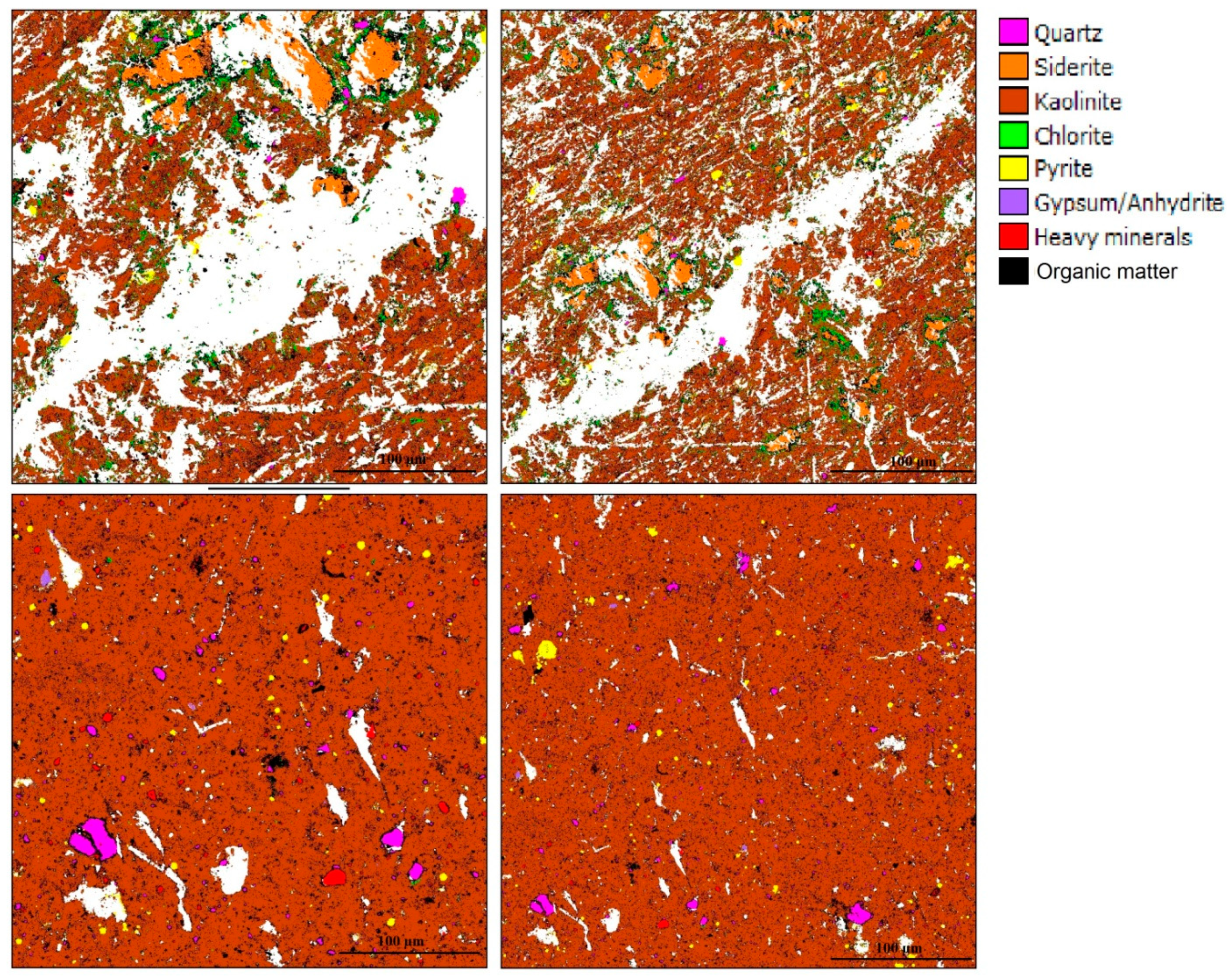
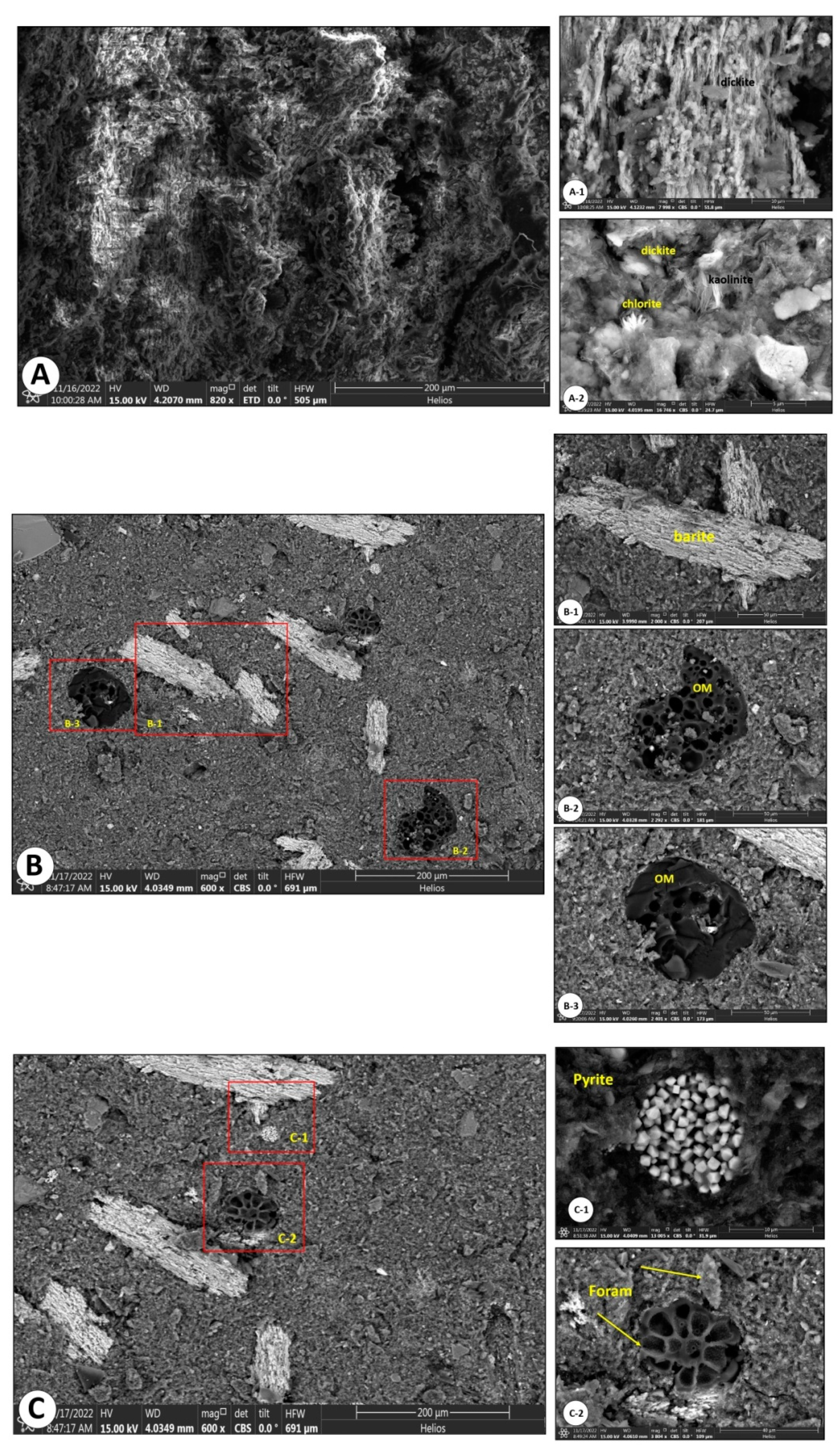
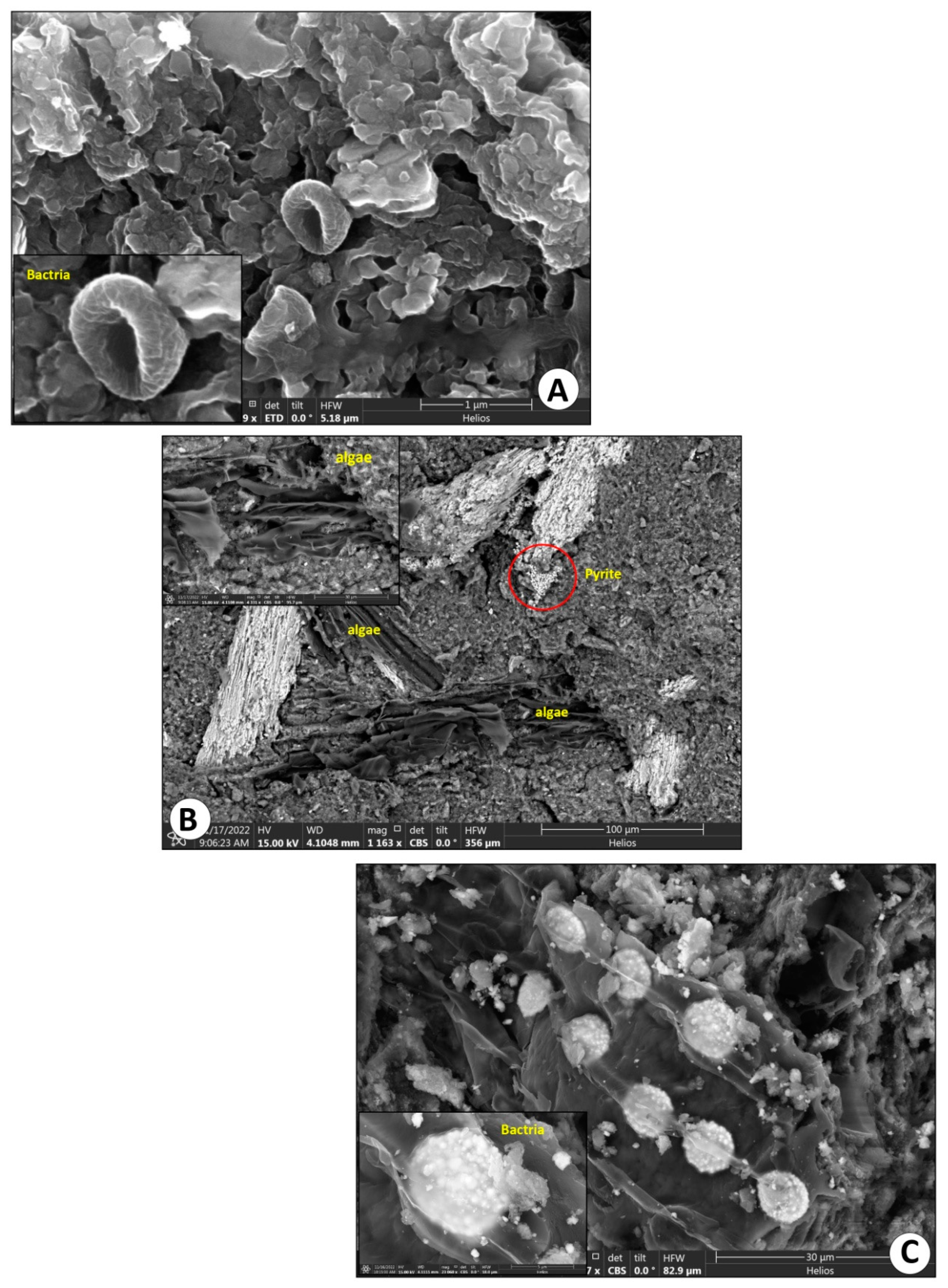

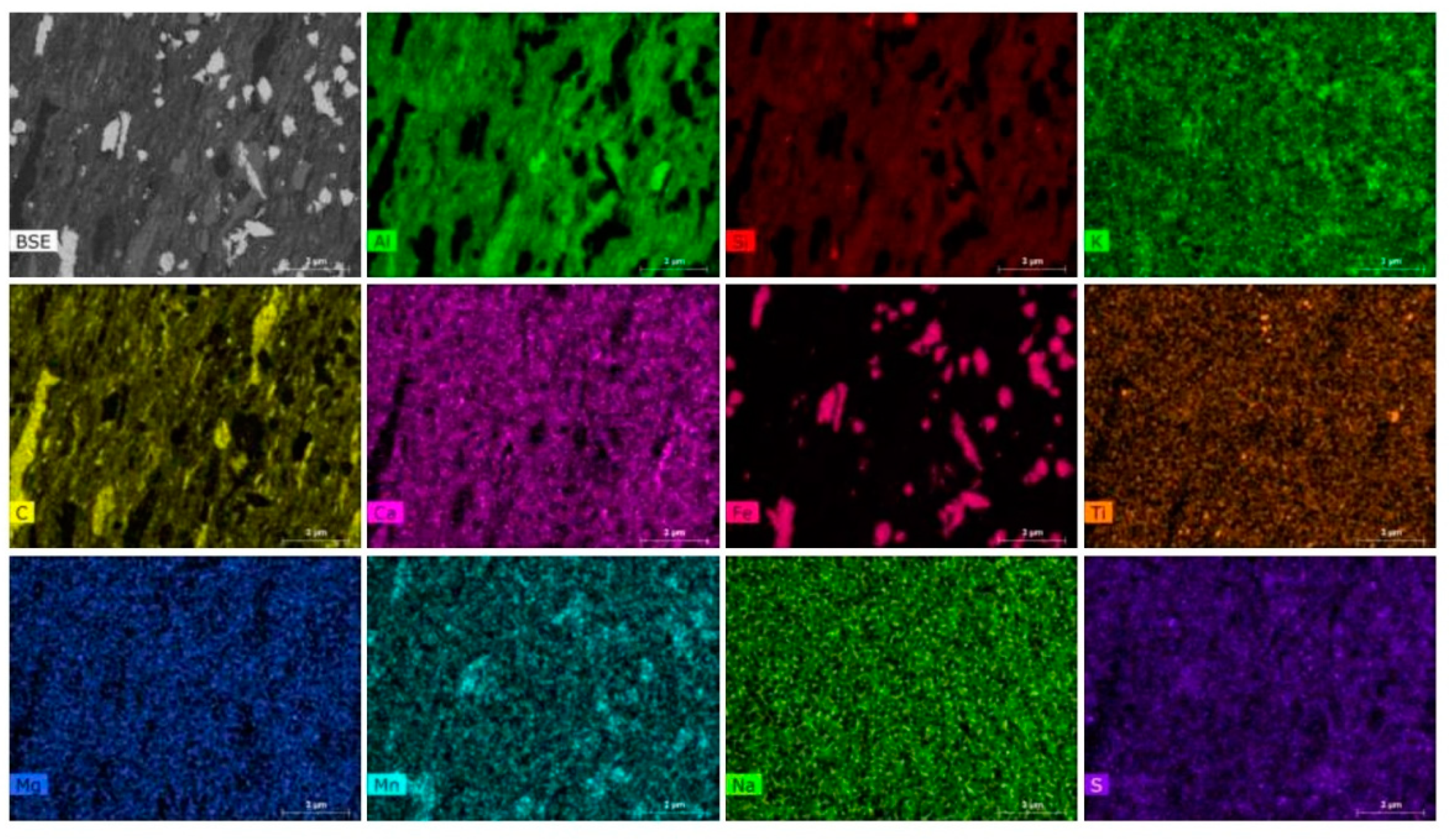
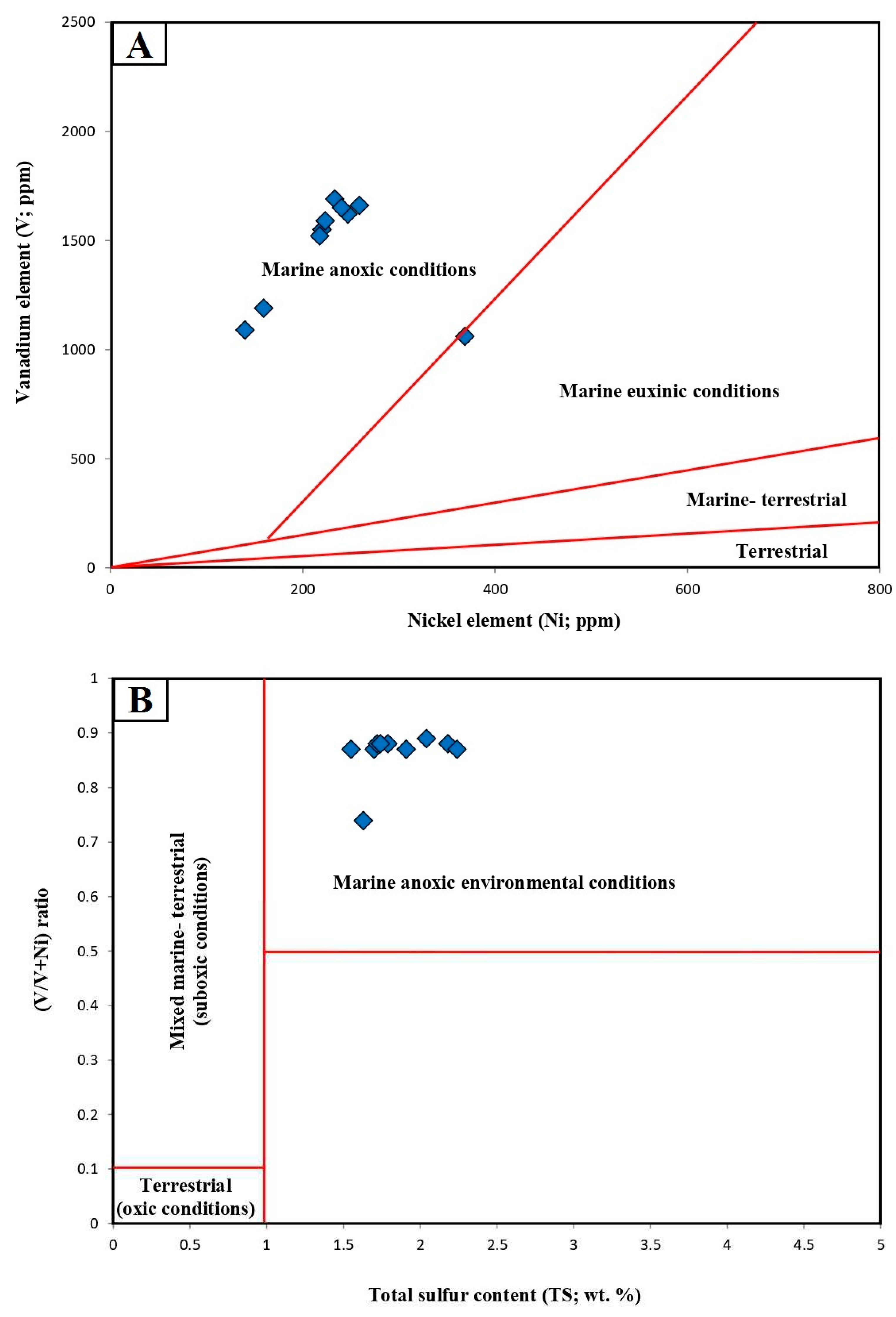
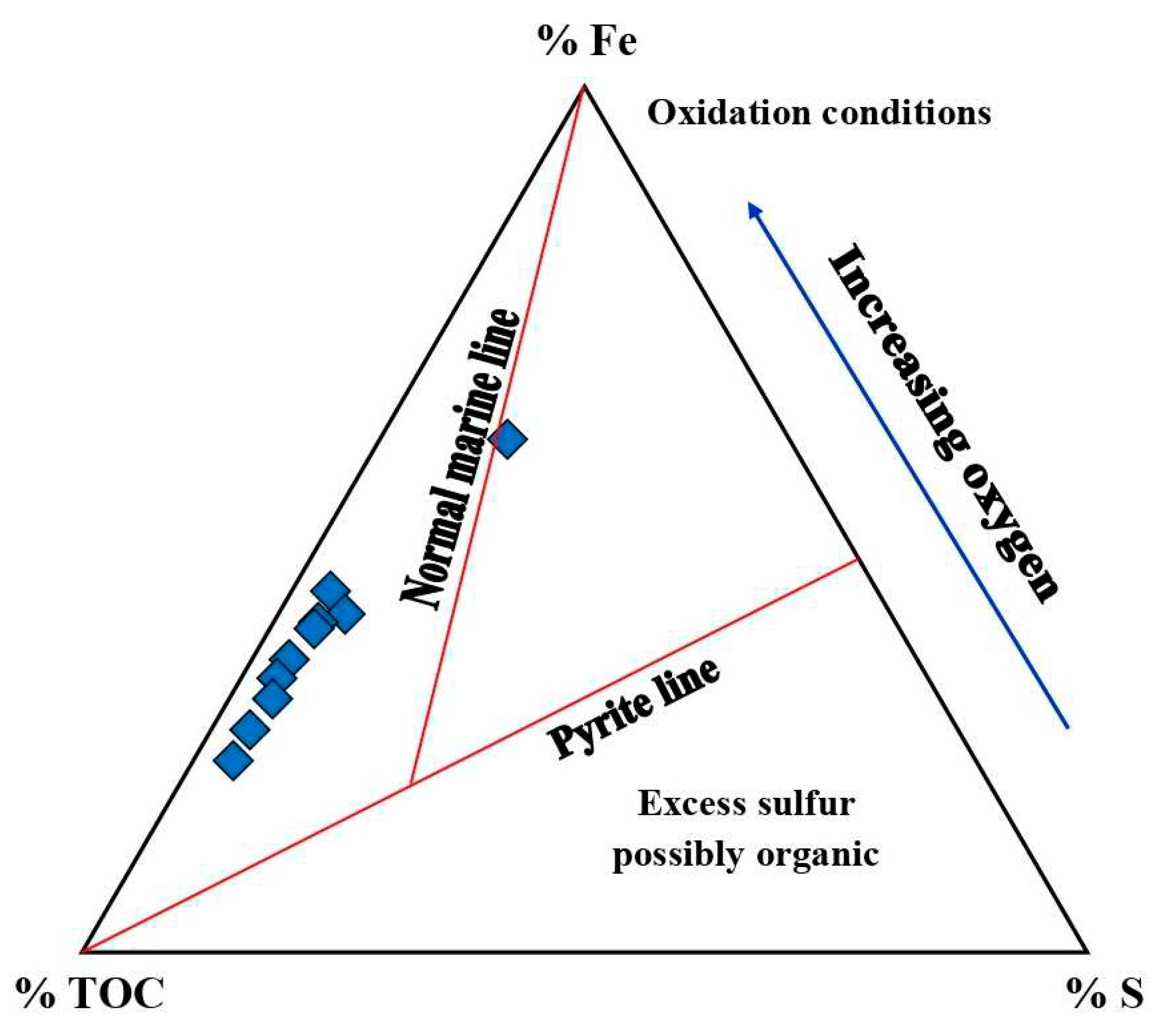
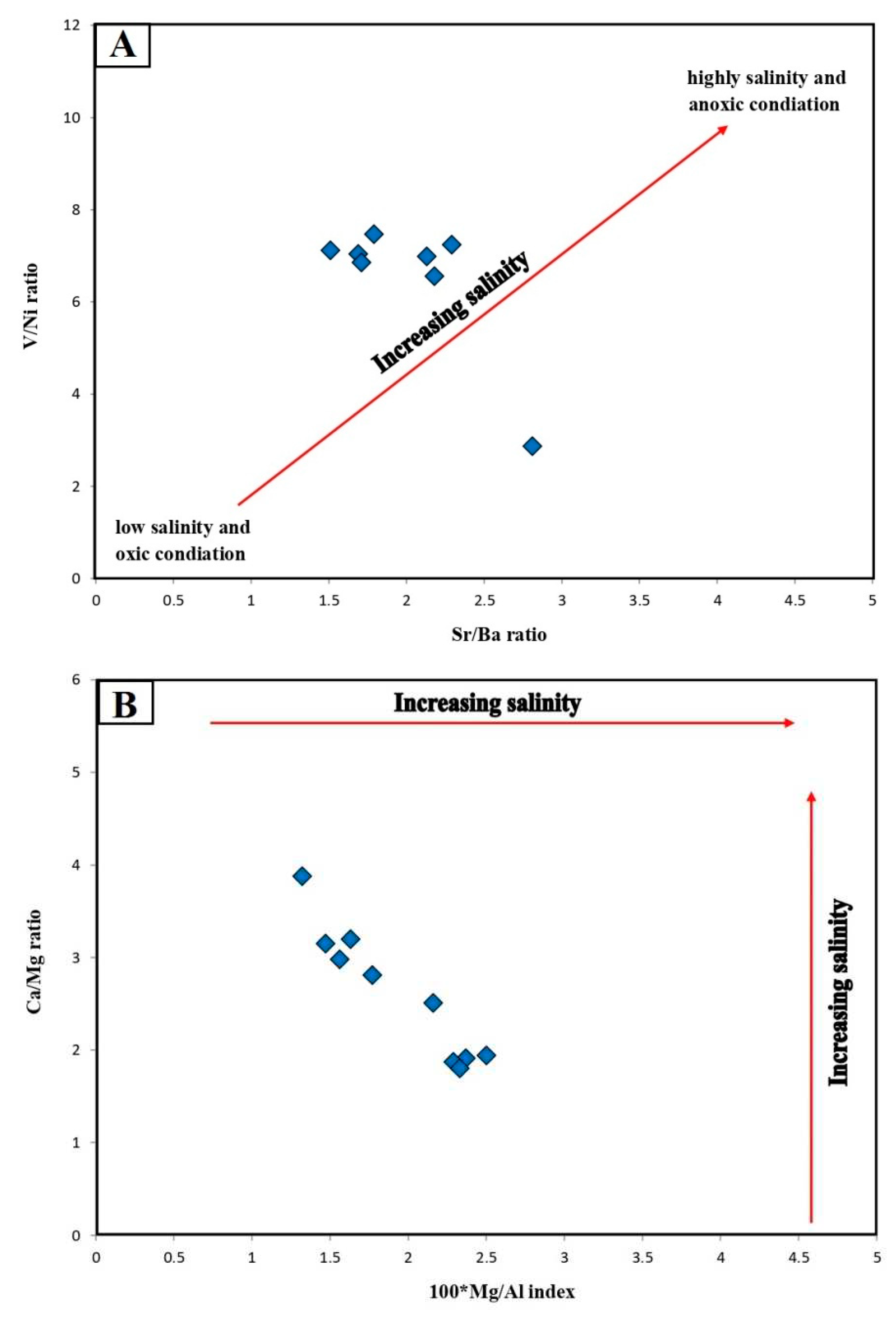
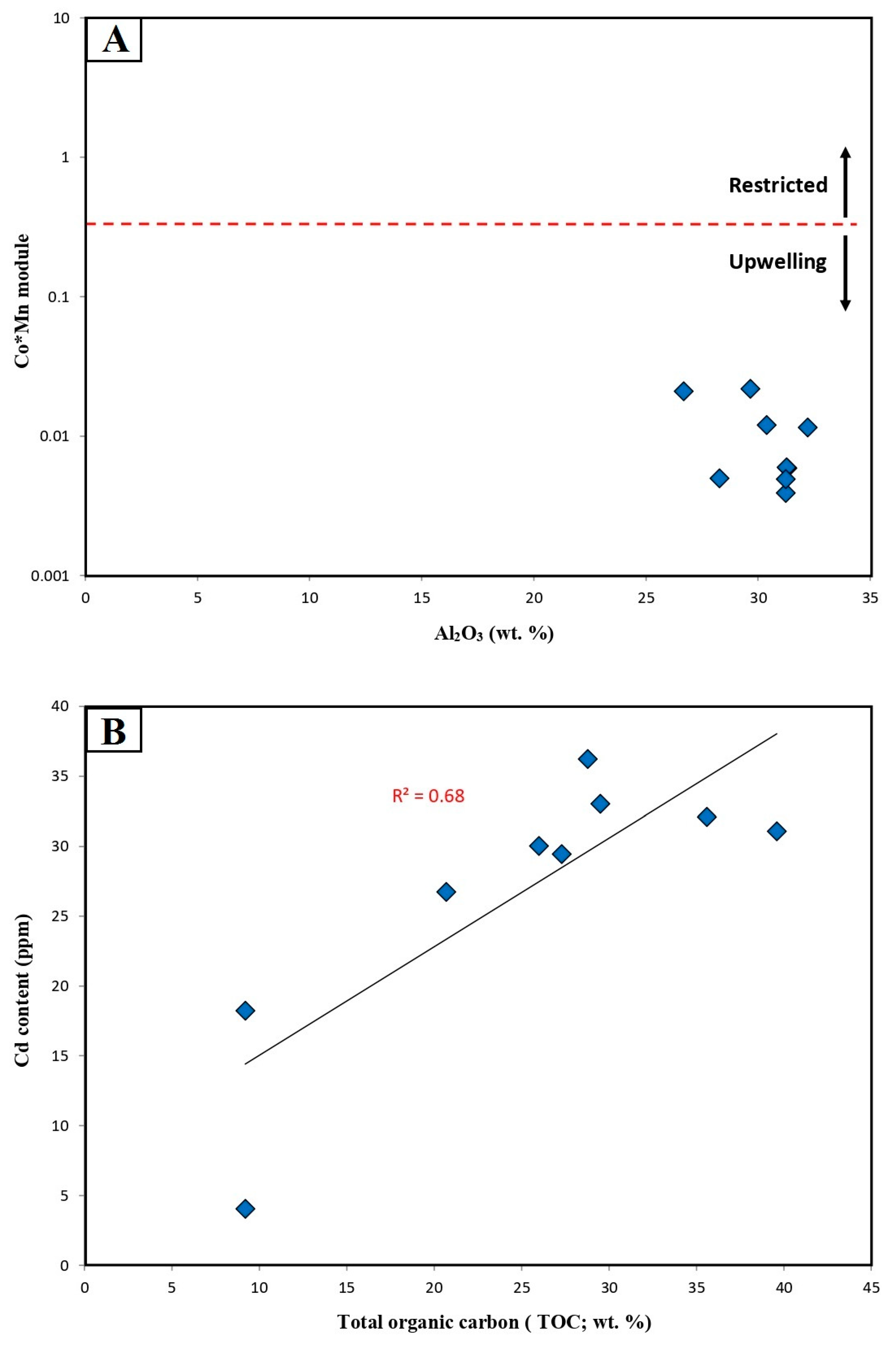
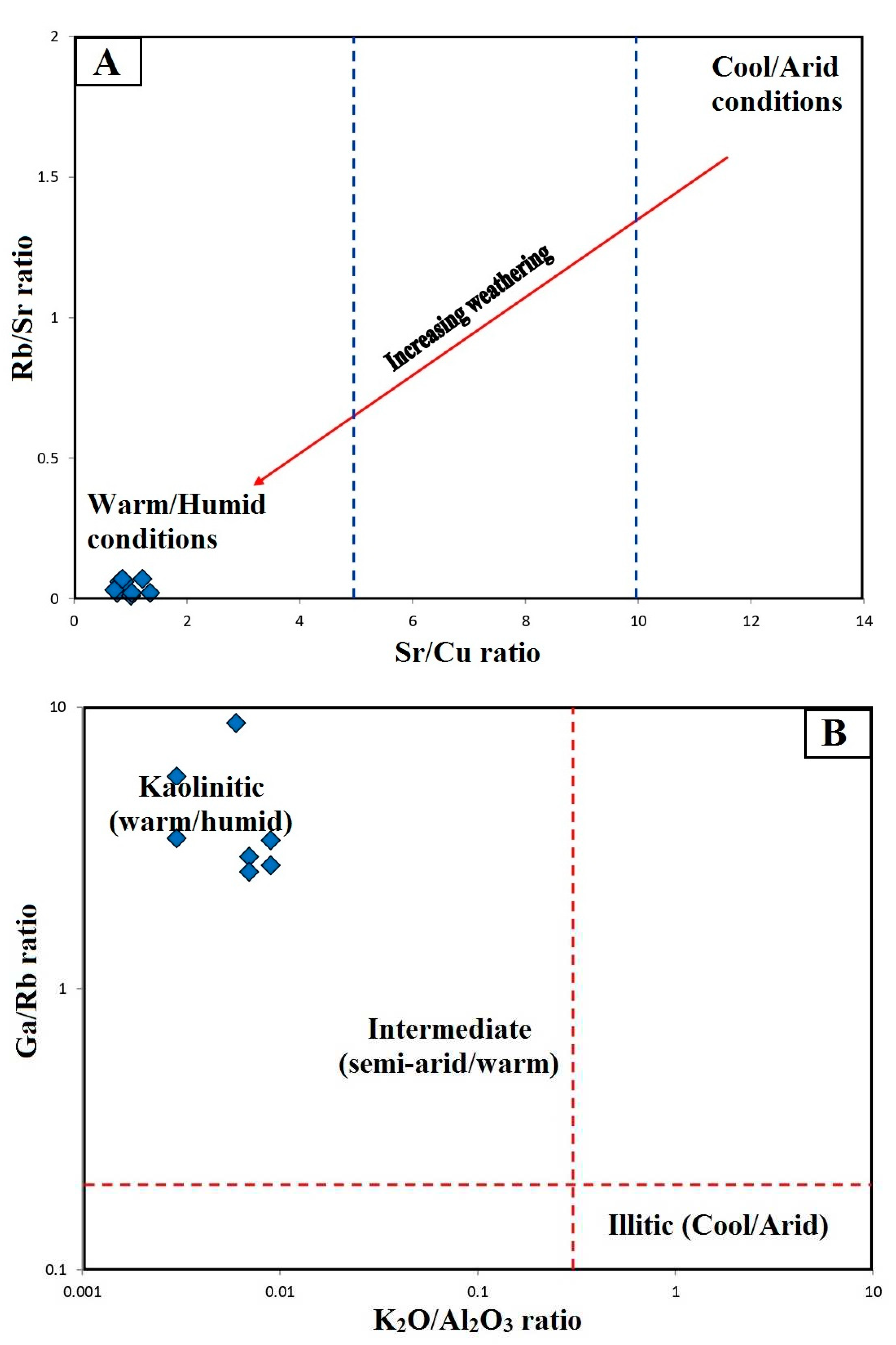
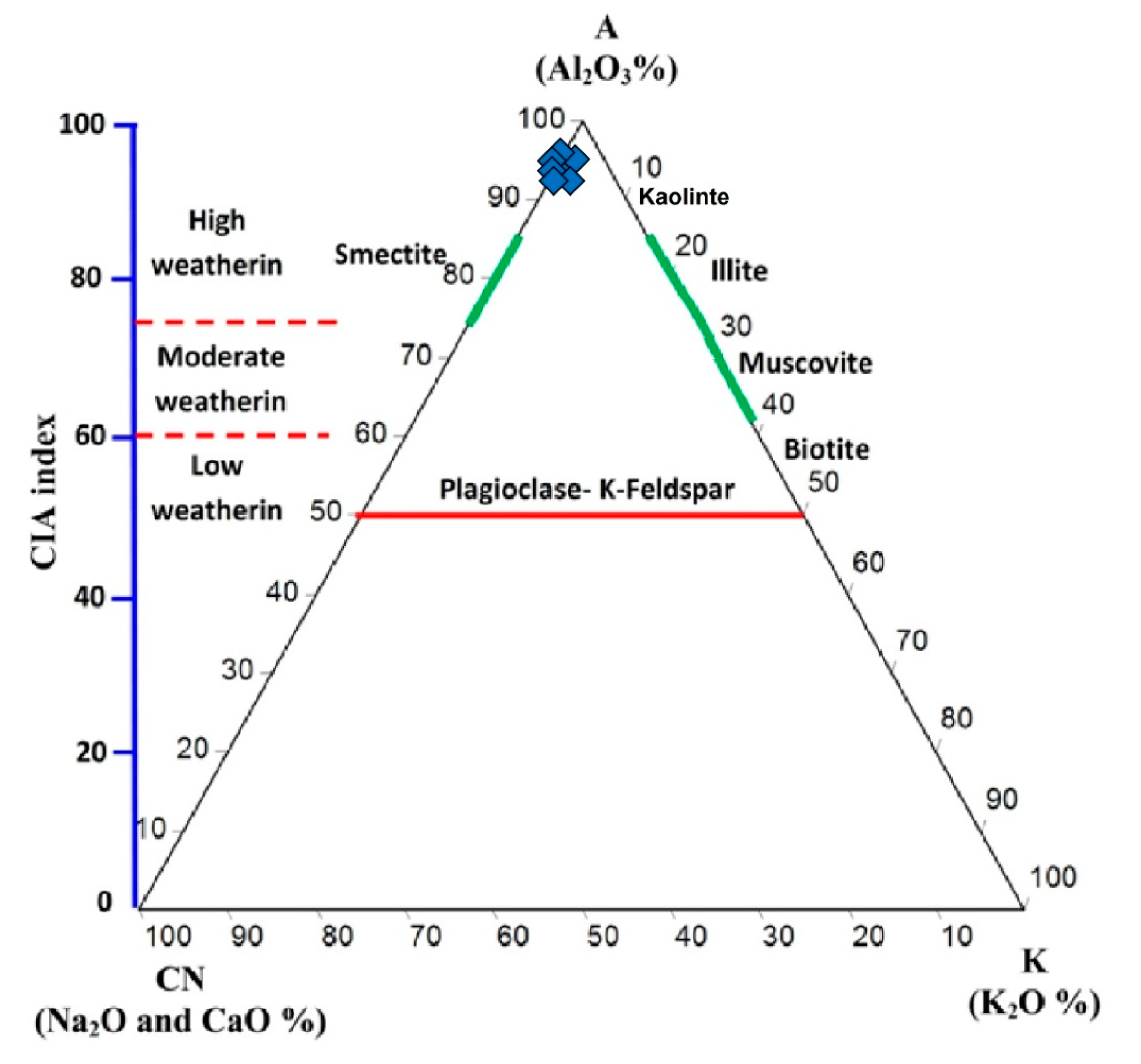
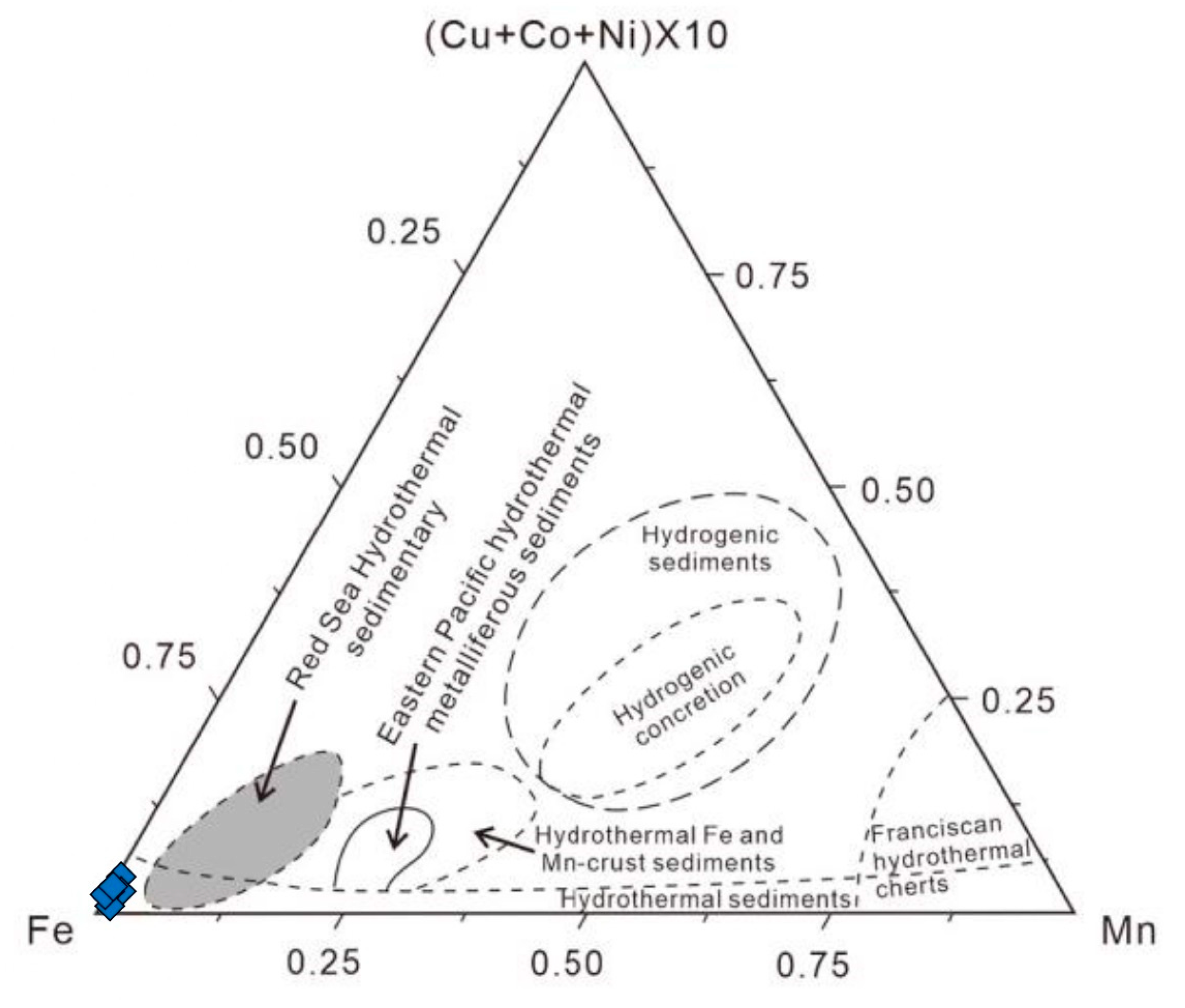
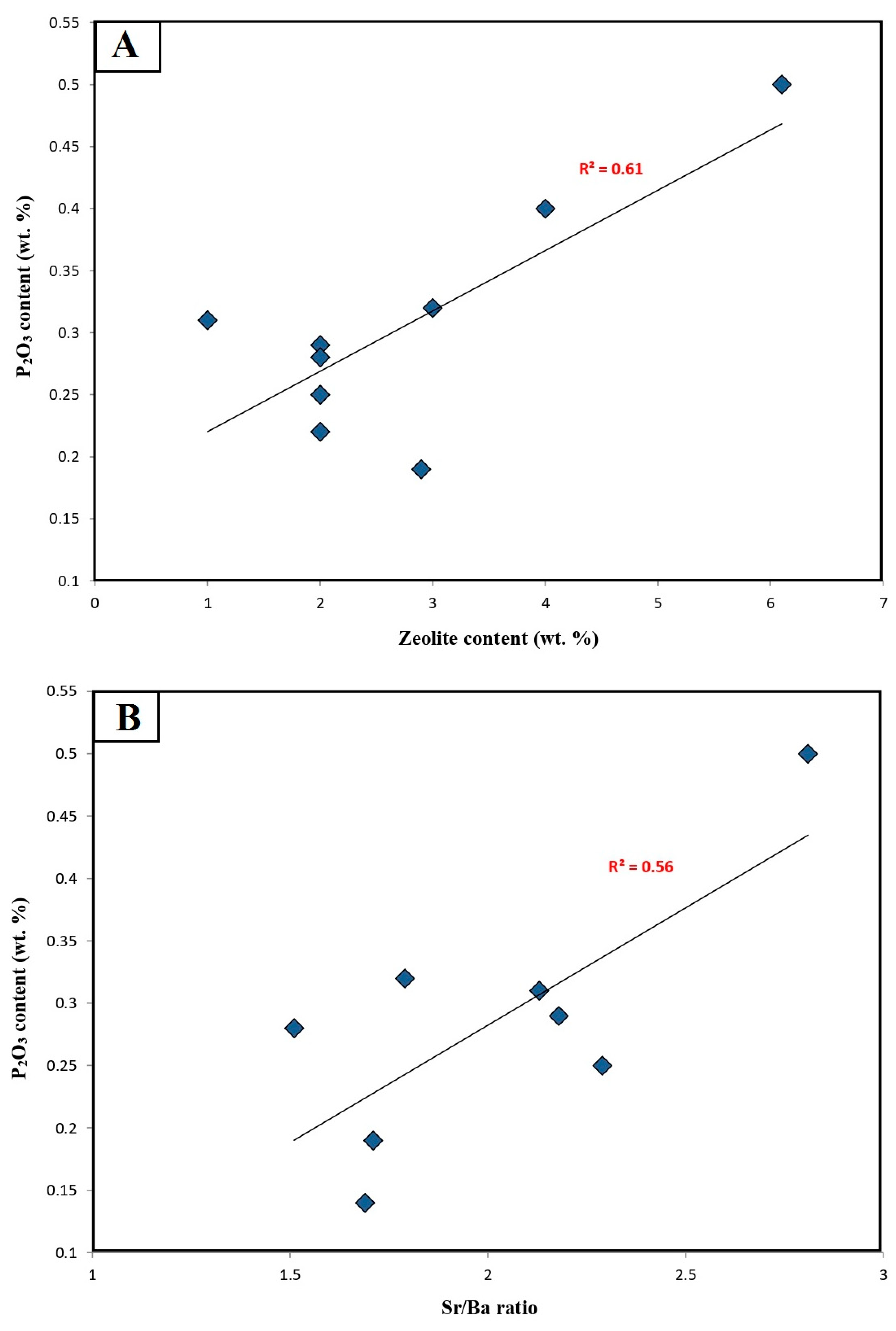
Disclaimer/Publisher’s Note: The statements, opinions and data contained in all publications are solely those of the individual author(s) and contributor(s) and not of MDPI and/or the editor(s). MDPI and/or the editor(s) disclaim responsibility for any injury to people or property resulting from any ideas, methods, instructions or products referred to in the content. |
© 2023 by the authors. Licensee MDPI, Basel, Switzerland. This article is an open access article distributed under the terms and conditions of the Creative Commons Attribution (CC BY) license (http://creativecommons.org/licenses/by/4.0/).




